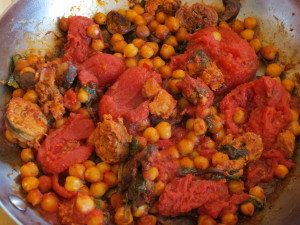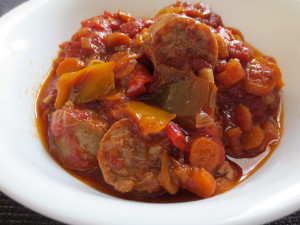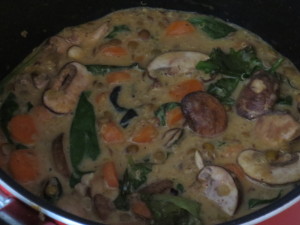Forget milk and bread! Here are some hot, nutritious and great-tasting meals you can make at home if you’re off work today and have the ingredients. Otherwise you can enjoy these the next time you make your grocery list.
The first is basically a pasta dish minus the pasta- using garbanzo beans instead. The garbanzo beans, or chickpeas, are lower on the glycemic scale than pasta. You also get the added benefit of fiber and plat-source protein. When you combine plant source protein with animal source protein or other dissimilar plant proteins, you then have more usable protein for your dietary needs. 
Soak the chickpeas overnight, or for six to eight hours. You can also use lentils without needing to soak them. When its time to prepare the meal, boil the dried goods for about twenty minutes. You can have a roiling boil for the first ten minutes, then cut it to medium for the next ten.
Place a link of chicken sausage in a pan on medium-high stovetop heat. Turn every few minutes when the sausage is browned. When the sausage is about three-quarters done, add the garbanzos and start cutting the sausage. The garbanzos will soak up the flavor from the juices. Add Cremini mushrooms. These particular mushrooms are one of the best sources for chromium- a mineral that helps to stabilize insulin and blood sugar. This is ideal when consuming a carbohydrate-rich meal. Most supplement forms of this mineral are inorganic, and are rejected by the body as a foreign agent.
Add spinach leaves to the mix, and as they are starting to wilt add the San Marzano or plum tomatoes. Let it all simmer for thirty minutes.
This next example is very closely related to the previous one- except that it is lower carbohydrate.  In this example, I substituted garbanzos with more vegetables- chopped carrots, onions, and peppers. It can be eaten as a thick and hearty soup. As before, start with the chicken sausage in the pan. With a little olive oil in the pan, add the carrots first since they’re more dense than the peppers and onions. With medium high heat, add chopped garlic, peppers and onions just a minute or two after the carrots. Turn/stir the mixture after five to seven minutes. The browning, or caramelization of the vegetables’ naturally-ocurring sugars (an extremely low amount) adds to the flavor. Once this mixture has been in the pan for fifteen minutes, add the plum tomatoes and let simmer for twenty-five to thirty minutes.
In this example, I substituted garbanzos with more vegetables- chopped carrots, onions, and peppers. It can be eaten as a thick and hearty soup. As before, start with the chicken sausage in the pan. With a little olive oil in the pan, add the carrots first since they’re more dense than the peppers and onions. With medium high heat, add chopped garlic, peppers and onions just a minute or two after the carrots. Turn/stir the mixture after five to seven minutes. The browning, or caramelization of the vegetables’ naturally-ocurring sugars (an extremely low amount) adds to the flavor. Once this mixture has been in the pan for fifteen minutes, add the plum tomatoes and let simmer for twenty-five to thirty minutes.
This final example is a soup made with strictly vegan sources- lentils and quinoa. These two dried goods provide a complete protein once combined in a meal. By themselves, they contain a ratio of amino acids (the building blocks of any body tissue) that is incomplete- the body will break down muscle mass or even organs to supply a specific amino acid or two in order to make use of the incoming dietary protein. 
Boil the dried goods as described in the first example. A bouillon cube can be used for flavor. If you would prefer less sodium or a vegan product, there are low-sodium non-animal source bouillon cube substitutes available at certain grocers. Once the quinoa husks have separated, add two tablespoons of coconut cream. In this case I also added a table spoon of a curry- you can use powdered spices or prepared sauces. Otherwise, any spice you enjoy will do. I then added chopped carrots, Cremini mushrooms, and finally spinach leaves/mixed greens.
When deciding portion sizes, a quarter cup of lentils, quinoa, or chickpeas provides 28-30 grams of carbohydrates. Here’s the difference: at least one-third of the lentils’ carbohydrates are fiber. Some Americans do not even acquire 10-15 grams of fiber per day. Nine of the garbanzos’ carbohydrate grams are fiber, and quinoa contains three grams. The lentils and garbanzos both contain about ten grams of protein per quarter cup, with quinoa containing six grams. The lentils and garbanzos are also lower on the glycemic scale than quinoa. The value of quinoa’s addition comes from its contribution in complementary plant-based protein when compared to lentils and garbanzos. In their absence, quinoa makes an interesting source of carbohydrate when paired with meat or vegetables.
For men, about twenty-five to thirty grams of protein per meal are ideal; women, about twenty to twenty-five tops. One large chicken sausage link contains about 15 grams of protein. The difference can be made with the excellent sources of plant-based protein that we have looked at today.
Multiple portions can be prepared for tupperware office lunches. All of the major nutrients- protein, carbohydrates, and fat- as well as the necessary micronutrients (vitamins, minerals, and phytochemicals) are provided in these meals. These are some of the popular topics and solutions we cover in my wellness seminars. Cooking healthy at home really is easy, affordable, and delicious!
Learn more about how to structure your diet and remove obstacles. Download your mp3 program “Goals and Nutrition” right here.
